Health Workforce Planning
VerifiedAdded on 2023/06/14
|14
|2709
|321
AI Summary
This report presents a framework on factors that influence health workforce planning in Australia, and advances that have been taken by the government to offset the current state of nursing workforce-related challenges. Key challenges are identified, and solutions suggested for implementation.
Contribute Materials
Your contribution can guide someone’s learning journey. Share your
documents today.
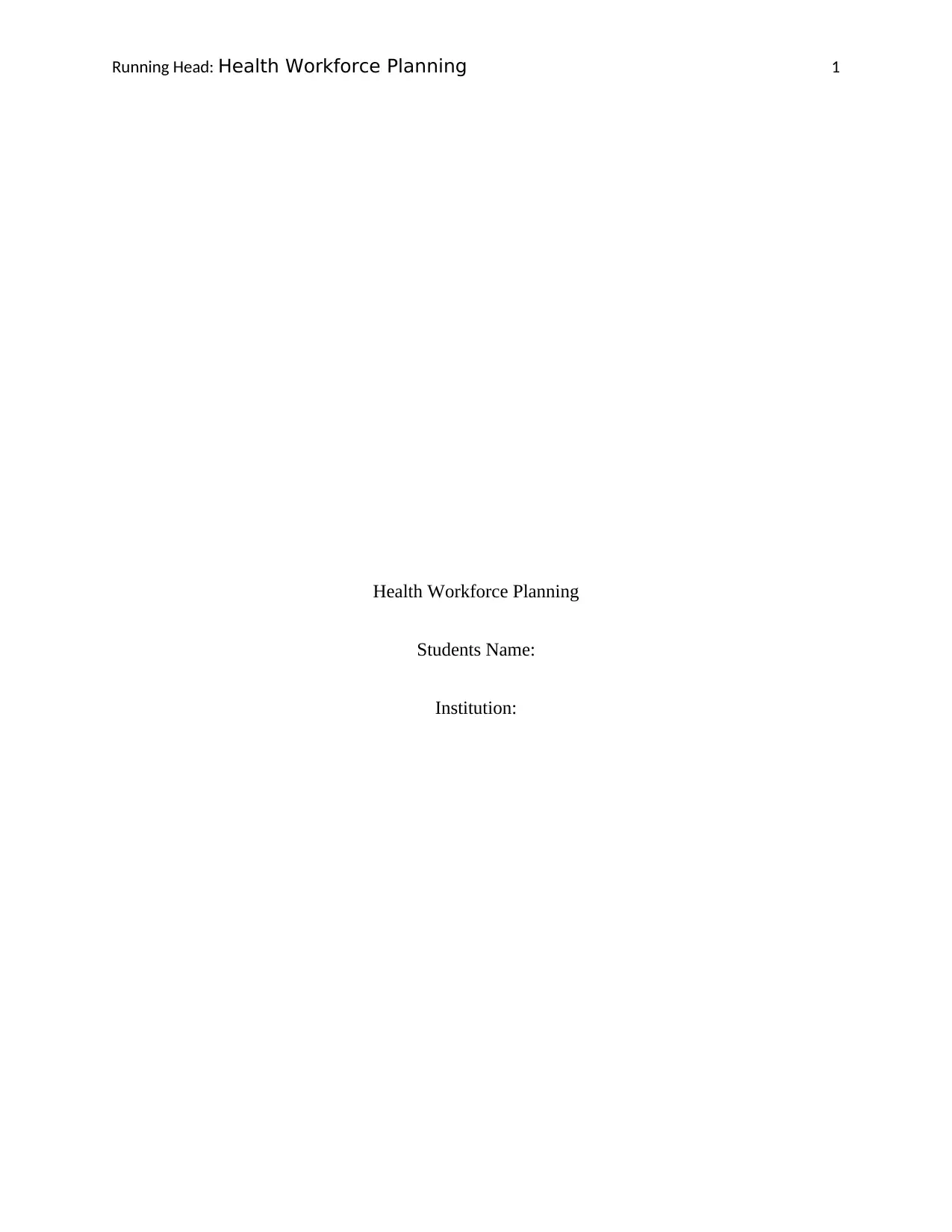
Running Head: Health Workforce Planning 1
Health Workforce Planning
Students Name:
Institution:
Health Workforce Planning
Students Name:
Institution:
Secure Best Marks with AI Grader
Need help grading? Try our AI Grader for instant feedback on your assignments.
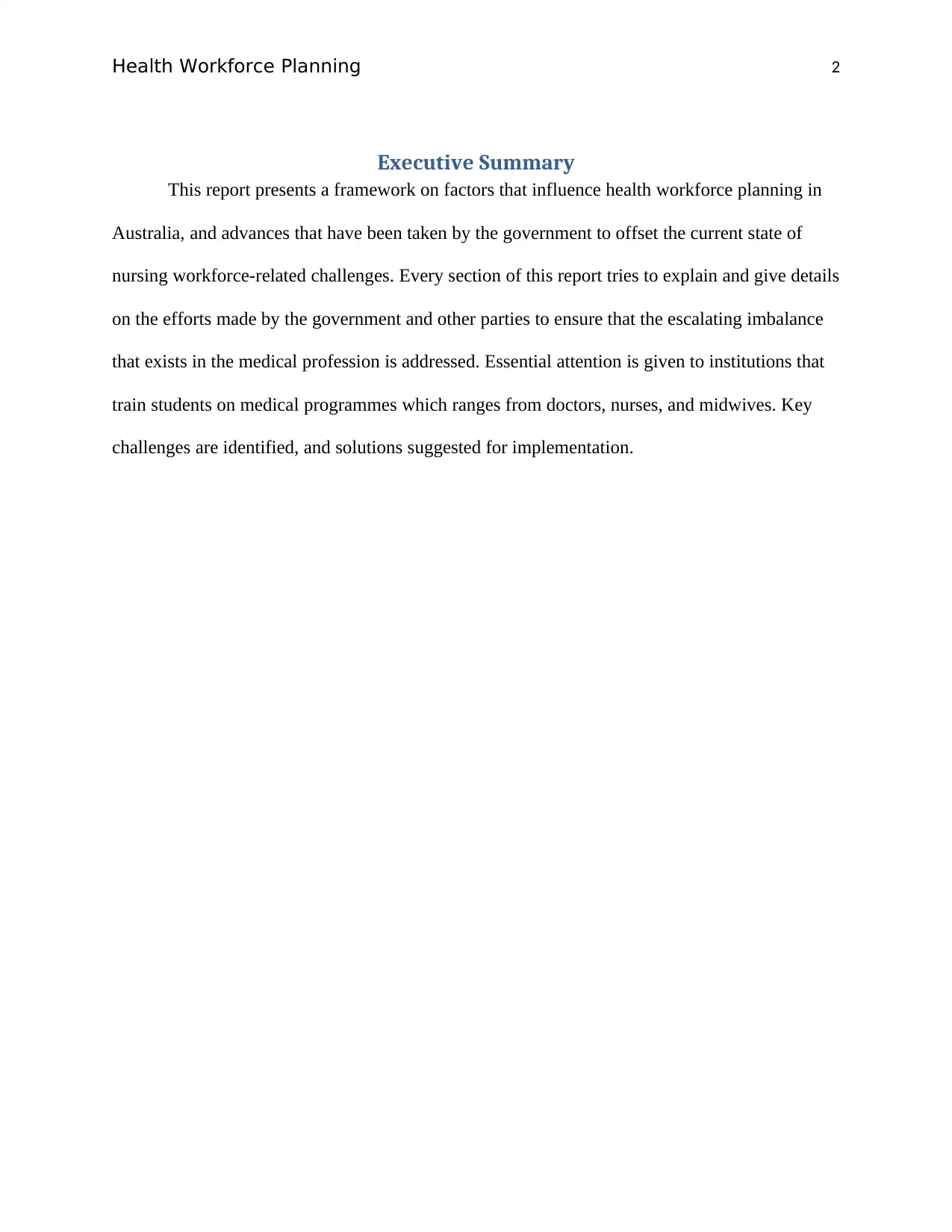
Health Workforce Planning 2
Executive Summary
This report presents a framework on factors that influence health workforce planning in
Australia, and advances that have been taken by the government to offset the current state of
nursing workforce-related challenges. Every section of this report tries to explain and give details
on the efforts made by the government and other parties to ensure that the escalating imbalance
that exists in the medical profession is addressed. Essential attention is given to institutions that
train students on medical programmes which ranges from doctors, nurses, and midwives. Key
challenges are identified, and solutions suggested for implementation.
Executive Summary
This report presents a framework on factors that influence health workforce planning in
Australia, and advances that have been taken by the government to offset the current state of
nursing workforce-related challenges. Every section of this report tries to explain and give details
on the efforts made by the government and other parties to ensure that the escalating imbalance
that exists in the medical profession is addressed. Essential attention is given to institutions that
train students on medical programmes which ranges from doctors, nurses, and midwives. Key
challenges are identified, and solutions suggested for implementation.
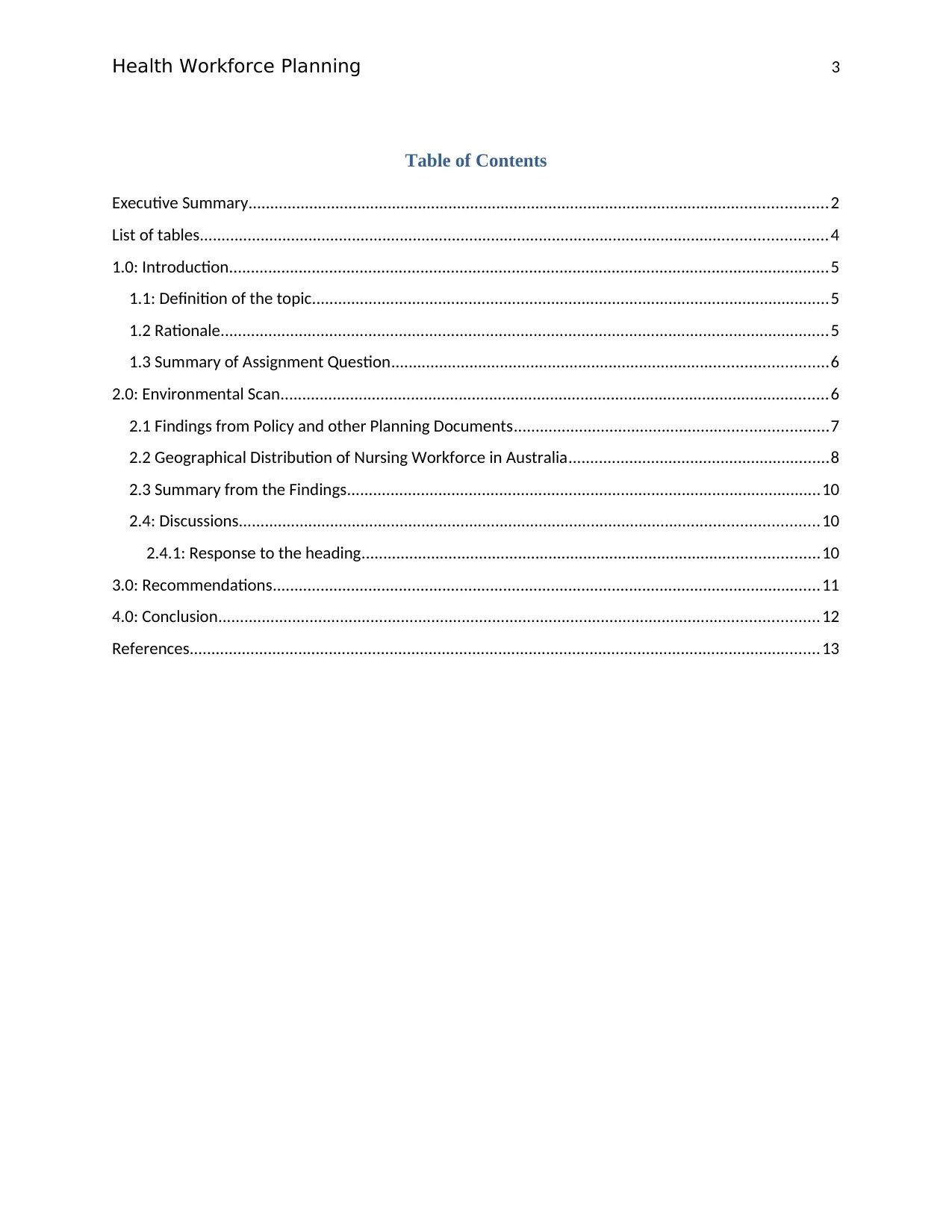
Health Workforce Planning 3
Table of Contents
Executive Summary.....................................................................................................................................2
List of tables................................................................................................................................................4
1.0: Introduction..........................................................................................................................................5
1.1: Definition of the topic.......................................................................................................................5
1.2 Rationale............................................................................................................................................5
1.3 Summary of Assignment Question....................................................................................................6
2.0: Environmental Scan..............................................................................................................................6
2.1 Findings from Policy and other Planning Documents........................................................................7
2.2 Geographical Distribution of Nursing Workforce in Australia............................................................8
2.3 Summary from the Findings.............................................................................................................10
2.4: Discussions.....................................................................................................................................10
2.4.1: Response to the heading.........................................................................................................10
3.0: Recommendations..............................................................................................................................11
4.0: Conclusion..........................................................................................................................................12
References.................................................................................................................................................13
Table of Contents
Executive Summary.....................................................................................................................................2
List of tables................................................................................................................................................4
1.0: Introduction..........................................................................................................................................5
1.1: Definition of the topic.......................................................................................................................5
1.2 Rationale............................................................................................................................................5
1.3 Summary of Assignment Question....................................................................................................6
2.0: Environmental Scan..............................................................................................................................6
2.1 Findings from Policy and other Planning Documents........................................................................7
2.2 Geographical Distribution of Nursing Workforce in Australia............................................................8
2.3 Summary from the Findings.............................................................................................................10
2.4: Discussions.....................................................................................................................................10
2.4.1: Response to the heading.........................................................................................................10
3.0: Recommendations..............................................................................................................................11
4.0: Conclusion..........................................................................................................................................12
References.................................................................................................................................................13
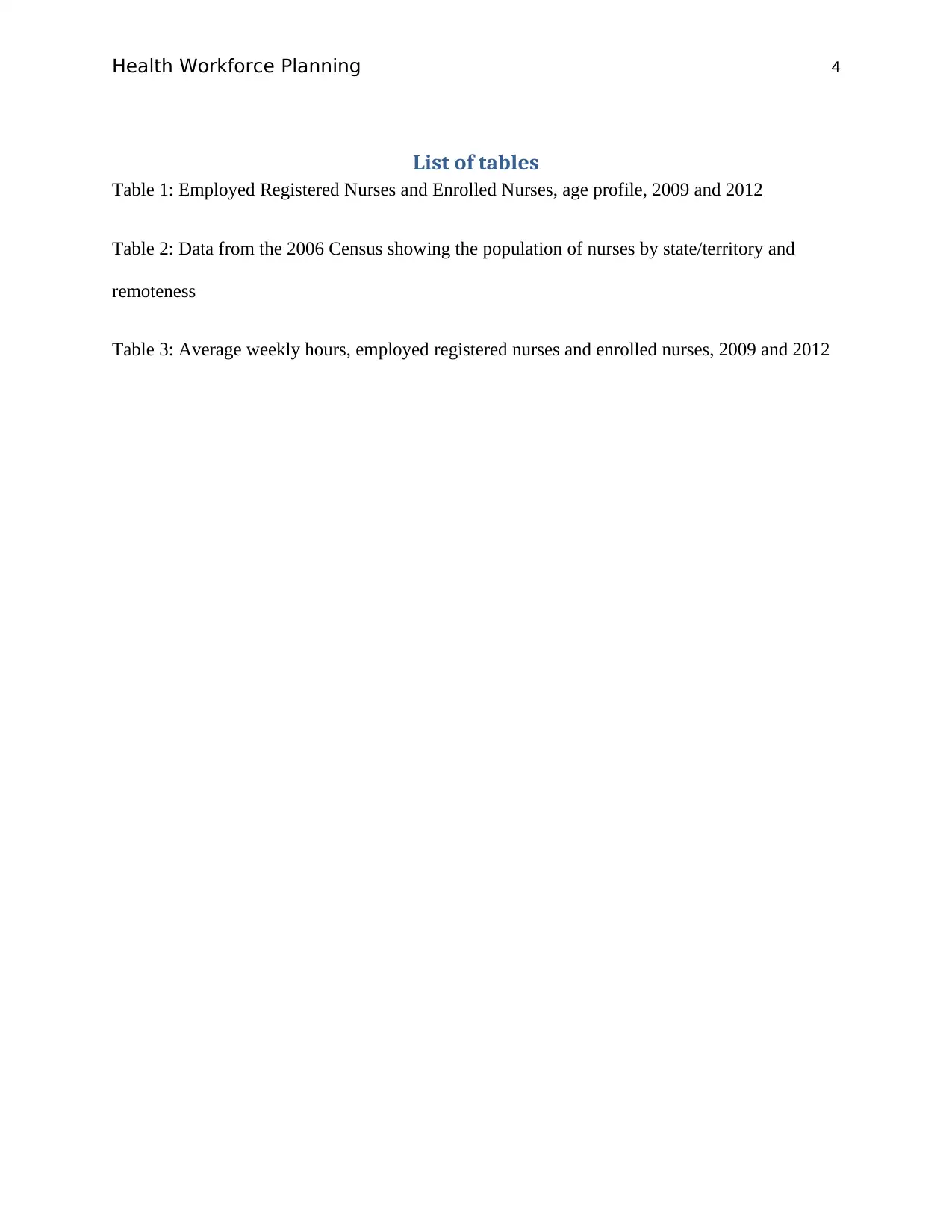
Health Workforce Planning 4
List of tables
Table 1: Employed Registered Nurses and Enrolled Nurses, age profile, 2009 and 2012
Table 2: Data from the 2006 Census showing the population of nurses by state/territory and
remoteness
Table 3: Average weekly hours, employed registered nurses and enrolled nurses, 2009 and 2012
List of tables
Table 1: Employed Registered Nurses and Enrolled Nurses, age profile, 2009 and 2012
Table 2: Data from the 2006 Census showing the population of nurses by state/territory and
remoteness
Table 3: Average weekly hours, employed registered nurses and enrolled nurses, 2009 and 2012
Secure Best Marks with AI Grader
Need help grading? Try our AI Grader for instant feedback on your assignments.
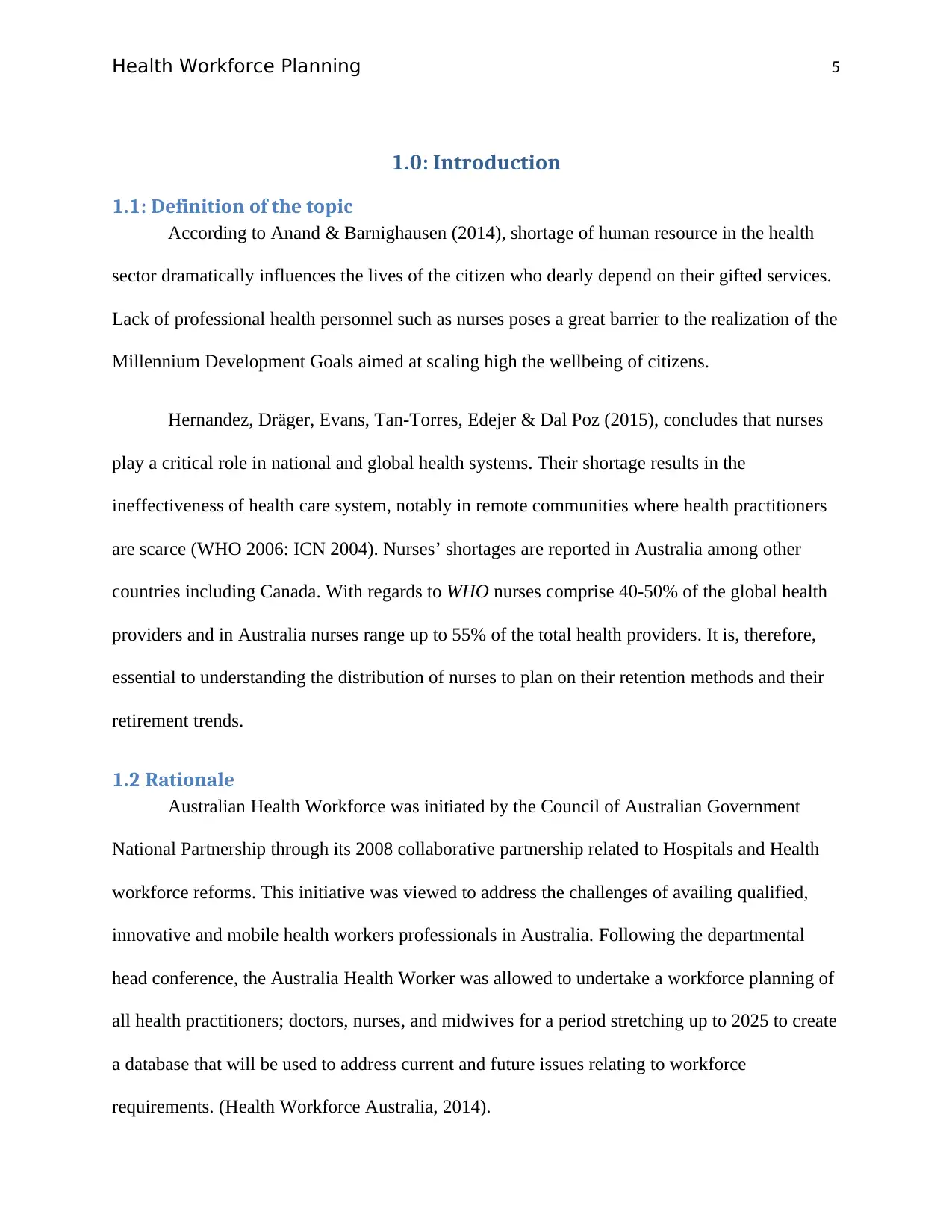
Health Workforce Planning 5
1.0: Introduction
1.1: Definition of the topic
According to Anand & Barnighausen (2014), shortage of human resource in the health
sector dramatically influences the lives of the citizen who dearly depend on their gifted services.
Lack of professional health personnel such as nurses poses a great barrier to the realization of the
Millennium Development Goals aimed at scaling high the wellbeing of citizens.
Hernandez, Dräger, Evans, Tan-Torres, Edejer & Dal Poz (2015), concludes that nurses
play a critical role in national and global health systems. Their shortage results in the
ineffectiveness of health care system, notably in remote communities where health practitioners
are scarce (WHO 2006: ICN 2004). Nurses’ shortages are reported in Australia among other
countries including Canada. With regards to WHO nurses comprise 40-50% of the global health
providers and in Australia nurses range up to 55% of the total health providers. It is, therefore,
essential to understanding the distribution of nurses to plan on their retention methods and their
retirement trends.
1.2 Rationale
Australian Health Workforce was initiated by the Council of Australian Government
National Partnership through its 2008 collaborative partnership related to Hospitals and Health
workforce reforms. This initiative was viewed to address the challenges of availing qualified,
innovative and mobile health workers professionals in Australia. Following the departmental
head conference, the Australia Health Worker was allowed to undertake a workforce planning of
all health practitioners; doctors, nurses, and midwives for a period stretching up to 2025 to create
a database that will be used to address current and future issues relating to workforce
requirements. (Health Workforce Australia, 2014).
1.0: Introduction
1.1: Definition of the topic
According to Anand & Barnighausen (2014), shortage of human resource in the health
sector dramatically influences the lives of the citizen who dearly depend on their gifted services.
Lack of professional health personnel such as nurses poses a great barrier to the realization of the
Millennium Development Goals aimed at scaling high the wellbeing of citizens.
Hernandez, Dräger, Evans, Tan-Torres, Edejer & Dal Poz (2015), concludes that nurses
play a critical role in national and global health systems. Their shortage results in the
ineffectiveness of health care system, notably in remote communities where health practitioners
are scarce (WHO 2006: ICN 2004). Nurses’ shortages are reported in Australia among other
countries including Canada. With regards to WHO nurses comprise 40-50% of the global health
providers and in Australia nurses range up to 55% of the total health providers. It is, therefore,
essential to understanding the distribution of nurses to plan on their retention methods and their
retirement trends.
1.2 Rationale
Australian Health Workforce was initiated by the Council of Australian Government
National Partnership through its 2008 collaborative partnership related to Hospitals and Health
workforce reforms. This initiative was viewed to address the challenges of availing qualified,
innovative and mobile health workers professionals in Australia. Following the departmental
head conference, the Australia Health Worker was allowed to undertake a workforce planning of
all health practitioners; doctors, nurses, and midwives for a period stretching up to 2025 to create
a database that will be used to address current and future issues relating to workforce
requirements. (Health Workforce Australia, 2014).
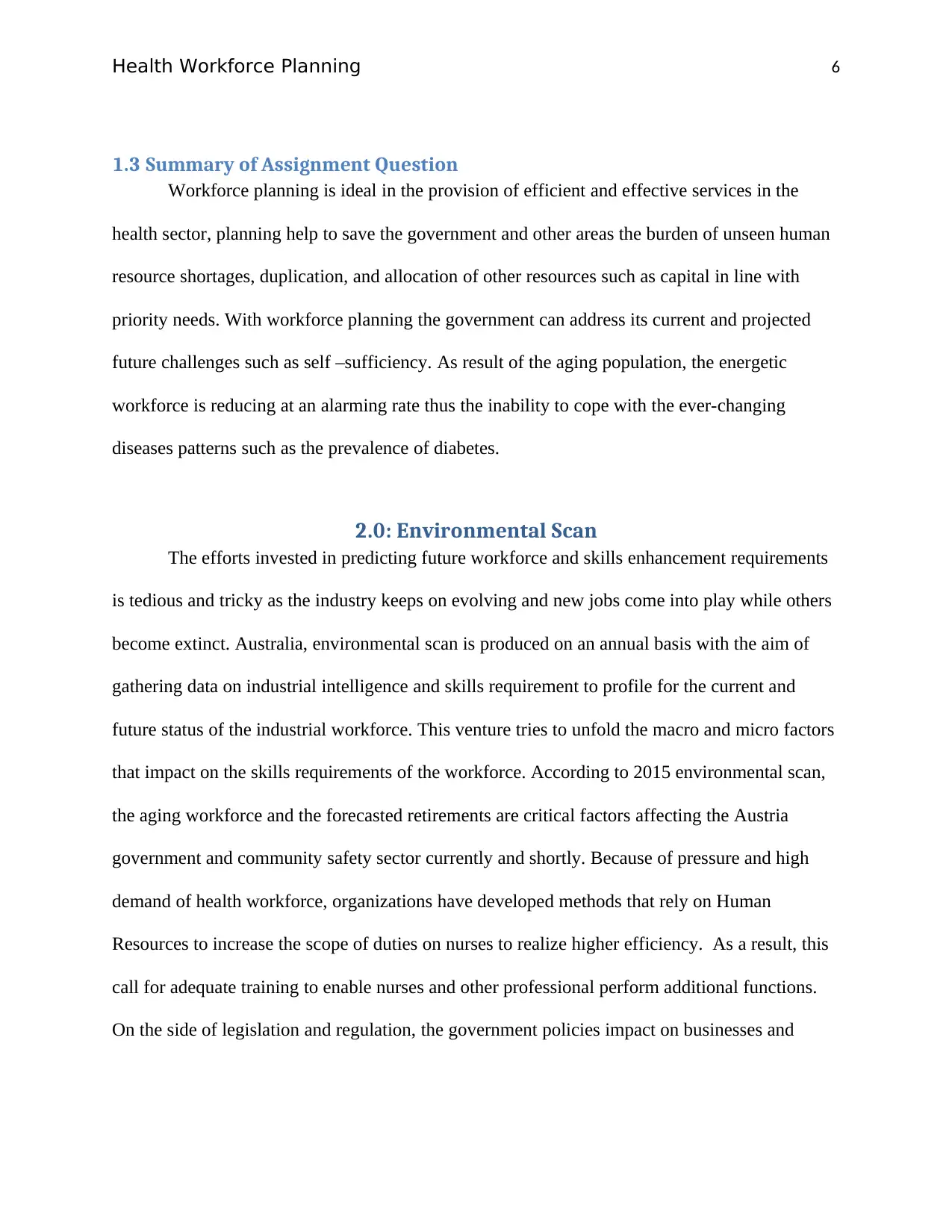
Health Workforce Planning 6
1.3 Summary of Assignment Question
Workforce planning is ideal in the provision of efficient and effective services in the
health sector, planning help to save the government and other areas the burden of unseen human
resource shortages, duplication, and allocation of other resources such as capital in line with
priority needs. With workforce planning the government can address its current and projected
future challenges such as self –sufficiency. As result of the aging population, the energetic
workforce is reducing at an alarming rate thus the inability to cope with the ever-changing
diseases patterns such as the prevalence of diabetes.
2.0: Environmental Scan
The efforts invested in predicting future workforce and skills enhancement requirements
is tedious and tricky as the industry keeps on evolving and new jobs come into play while others
become extinct. Australia, environmental scan is produced on an annual basis with the aim of
gathering data on industrial intelligence and skills requirement to profile for the current and
future status of the industrial workforce. This venture tries to unfold the macro and micro factors
that impact on the skills requirements of the workforce. According to 2015 environmental scan,
the aging workforce and the forecasted retirements are critical factors affecting the Austria
government and community safety sector currently and shortly. Because of pressure and high
demand of health workforce, organizations have developed methods that rely on Human
Resources to increase the scope of duties on nurses to realize higher efficiency. As a result, this
call for adequate training to enable nurses and other professional perform additional functions.
On the side of legislation and regulation, the government policies impact on businesses and
1.3 Summary of Assignment Question
Workforce planning is ideal in the provision of efficient and effective services in the
health sector, planning help to save the government and other areas the burden of unseen human
resource shortages, duplication, and allocation of other resources such as capital in line with
priority needs. With workforce planning the government can address its current and projected
future challenges such as self –sufficiency. As result of the aging population, the energetic
workforce is reducing at an alarming rate thus the inability to cope with the ever-changing
diseases patterns such as the prevalence of diabetes.
2.0: Environmental Scan
The efforts invested in predicting future workforce and skills enhancement requirements
is tedious and tricky as the industry keeps on evolving and new jobs come into play while others
become extinct. Australia, environmental scan is produced on an annual basis with the aim of
gathering data on industrial intelligence and skills requirement to profile for the current and
future status of the industrial workforce. This venture tries to unfold the macro and micro factors
that impact on the skills requirements of the workforce. According to 2015 environmental scan,
the aging workforce and the forecasted retirements are critical factors affecting the Austria
government and community safety sector currently and shortly. Because of pressure and high
demand of health workforce, organizations have developed methods that rely on Human
Resources to increase the scope of duties on nurses to realize higher efficiency. As a result, this
call for adequate training to enable nurses and other professional perform additional functions.
On the side of legislation and regulation, the government policies impact on businesses and
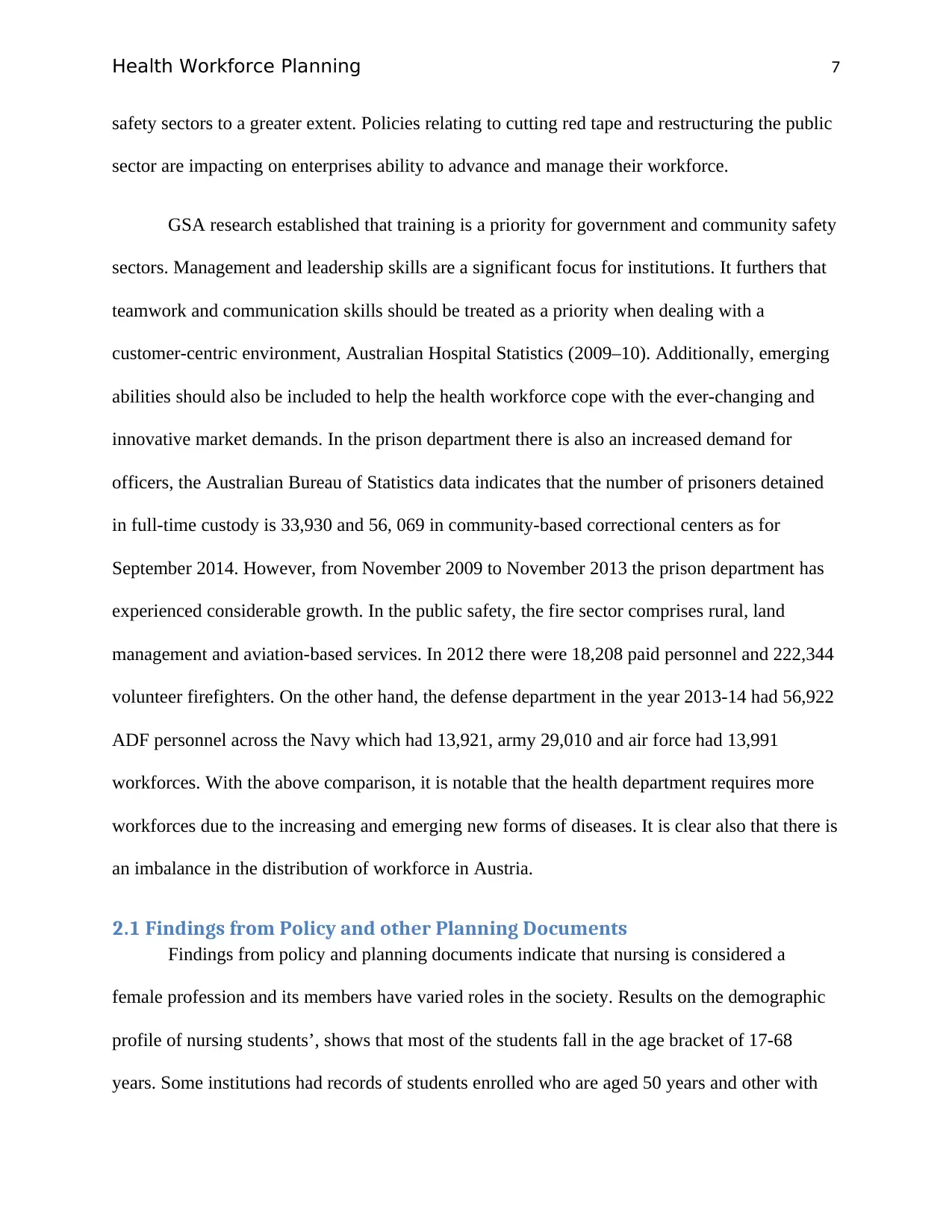
Health Workforce Planning 7
safety sectors to a greater extent. Policies relating to cutting red tape and restructuring the public
sector are impacting on enterprises ability to advance and manage their workforce.
GSA research established that training is a priority for government and community safety
sectors. Management and leadership skills are a significant focus for institutions. It furthers that
teamwork and communication skills should be treated as a priority when dealing with a
customer-centric environment, Australian Hospital Statistics (2009–10). Additionally, emerging
abilities should also be included to help the health workforce cope with the ever-changing and
innovative market demands. In the prison department there is also an increased demand for
officers, the Australian Bureau of Statistics data indicates that the number of prisoners detained
in full-time custody is 33,930 and 56, 069 in community-based correctional centers as for
September 2014. However, from November 2009 to November 2013 the prison department has
experienced considerable growth. In the public safety, the fire sector comprises rural, land
management and aviation-based services. In 2012 there were 18,208 paid personnel and 222,344
volunteer firefighters. On the other hand, the defense department in the year 2013-14 had 56,922
ADF personnel across the Navy which had 13,921, army 29,010 and air force had 13,991
workforces. With the above comparison, it is notable that the health department requires more
workforces due to the increasing and emerging new forms of diseases. It is clear also that there is
an imbalance in the distribution of workforce in Austria.
2.1 Findings from Policy and other Planning Documents
Findings from policy and planning documents indicate that nursing is considered a
female profession and its members have varied roles in the society. Results on the demographic
profile of nursing students’, shows that most of the students fall in the age bracket of 17-68
years. Some institutions had records of students enrolled who are aged 50 years and other with
safety sectors to a greater extent. Policies relating to cutting red tape and restructuring the public
sector are impacting on enterprises ability to advance and manage their workforce.
GSA research established that training is a priority for government and community safety
sectors. Management and leadership skills are a significant focus for institutions. It furthers that
teamwork and communication skills should be treated as a priority when dealing with a
customer-centric environment, Australian Hospital Statistics (2009–10). Additionally, emerging
abilities should also be included to help the health workforce cope with the ever-changing and
innovative market demands. In the prison department there is also an increased demand for
officers, the Australian Bureau of Statistics data indicates that the number of prisoners detained
in full-time custody is 33,930 and 56, 069 in community-based correctional centers as for
September 2014. However, from November 2009 to November 2013 the prison department has
experienced considerable growth. In the public safety, the fire sector comprises rural, land
management and aviation-based services. In 2012 there were 18,208 paid personnel and 222,344
volunteer firefighters. On the other hand, the defense department in the year 2013-14 had 56,922
ADF personnel across the Navy which had 13,921, army 29,010 and air force had 13,991
workforces. With the above comparison, it is notable that the health department requires more
workforces due to the increasing and emerging new forms of diseases. It is clear also that there is
an imbalance in the distribution of workforce in Austria.
2.1 Findings from Policy and other Planning Documents
Findings from policy and planning documents indicate that nursing is considered a
female profession and its members have varied roles in the society. Results on the demographic
profile of nursing students’, shows that most of the students fall in the age bracket of 17-68
years. Some institutions had records of students enrolled who are aged 50 years and other with
Paraphrase This Document
Need a fresh take? Get an instant paraphrase of this document with our AI Paraphraser
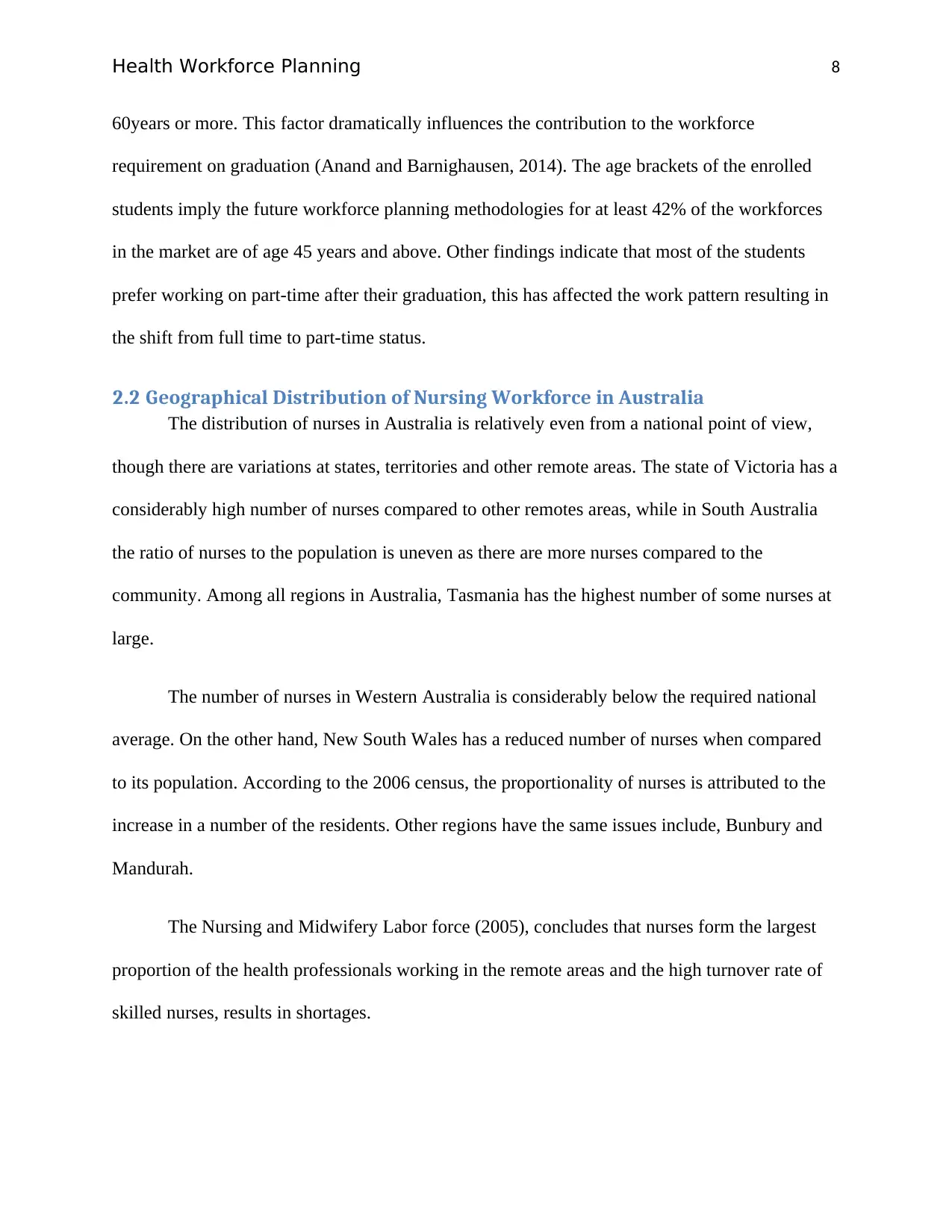
Health Workforce Planning 8
60years or more. This factor dramatically influences the contribution to the workforce
requirement on graduation (Anand and Barnighausen, 2014). The age brackets of the enrolled
students imply the future workforce planning methodologies for at least 42% of the workforces
in the market are of age 45 years and above. Other findings indicate that most of the students
prefer working on part-time after their graduation, this has affected the work pattern resulting in
the shift from full time to part-time status.
2.2 Geographical Distribution of Nursing Workforce in Australia
The distribution of nurses in Australia is relatively even from a national point of view,
though there are variations at states, territories and other remote areas. The state of Victoria has a
considerably high number of nurses compared to other remotes areas, while in South Australia
the ratio of nurses to the population is uneven as there are more nurses compared to the
community. Among all regions in Australia, Tasmania has the highest number of some nurses at
large.
The number of nurses in Western Australia is considerably below the required national
average. On the other hand, New South Wales has a reduced number of nurses when compared
to its population. According to the 2006 census, the proportionality of nurses is attributed to the
increase in a number of the residents. Other regions have the same issues include, Bunbury and
Mandurah.
The Nursing and Midwifery Labor force (2005), concludes that nurses form the largest
proportion of the health professionals working in the remote areas and the high turnover rate of
skilled nurses, results in shortages.
60years or more. This factor dramatically influences the contribution to the workforce
requirement on graduation (Anand and Barnighausen, 2014). The age brackets of the enrolled
students imply the future workforce planning methodologies for at least 42% of the workforces
in the market are of age 45 years and above. Other findings indicate that most of the students
prefer working on part-time after their graduation, this has affected the work pattern resulting in
the shift from full time to part-time status.
2.2 Geographical Distribution of Nursing Workforce in Australia
The distribution of nurses in Australia is relatively even from a national point of view,
though there are variations at states, territories and other remote areas. The state of Victoria has a
considerably high number of nurses compared to other remotes areas, while in South Australia
the ratio of nurses to the population is uneven as there are more nurses compared to the
community. Among all regions in Australia, Tasmania has the highest number of some nurses at
large.
The number of nurses in Western Australia is considerably below the required national
average. On the other hand, New South Wales has a reduced number of nurses when compared
to its population. According to the 2006 census, the proportionality of nurses is attributed to the
increase in a number of the residents. Other regions have the same issues include, Bunbury and
Mandurah.
The Nursing and Midwifery Labor force (2005), concludes that nurses form the largest
proportion of the health professionals working in the remote areas and the high turnover rate of
skilled nurses, results in shortages.

Health Workforce Planning 9
Table 1: Employed Registered Nurses and Enrolled Nurses, age profile, 2009 and 2012
2009 2012
Type of Nurse Average age Percentage age Average age Percentage age
Registered
nurses
44.2 19.9 44.3 22.5
Enrolled Nurses 44.9 19,3 46 25.9
All Nurses 44.3 19.3 44.6 23.1
Table 2: Data from the 2006 Census showing the population of nurses by state/territory and
remoteness
Major
Cities
Inner
Regional
Outer
Regional
Remote Very
Remote
National 1,137 1200 1000 1090 1400
SA 1,400 750 1250 1460 1600
WA 1,164 773 1,153 1,086 1,139
NSW 1,016 1,157 952 1,122 1080
Table 1: Employed Registered Nurses and Enrolled Nurses, age profile, 2009 and 2012
2009 2012
Type of Nurse Average age Percentage age Average age Percentage age
Registered
nurses
44.2 19.9 44.3 22.5
Enrolled Nurses 44.9 19,3 46 25.9
All Nurses 44.3 19.3 44.6 23.1
Table 2: Data from the 2006 Census showing the population of nurses by state/territory and
remoteness
Major
Cities
Inner
Regional
Outer
Regional
Remote Very
Remote
National 1,137 1200 1000 1090 1400
SA 1,400 750 1250 1460 1600
WA 1,164 773 1,153 1,086 1,139
NSW 1,016 1,157 952 1,122 1080
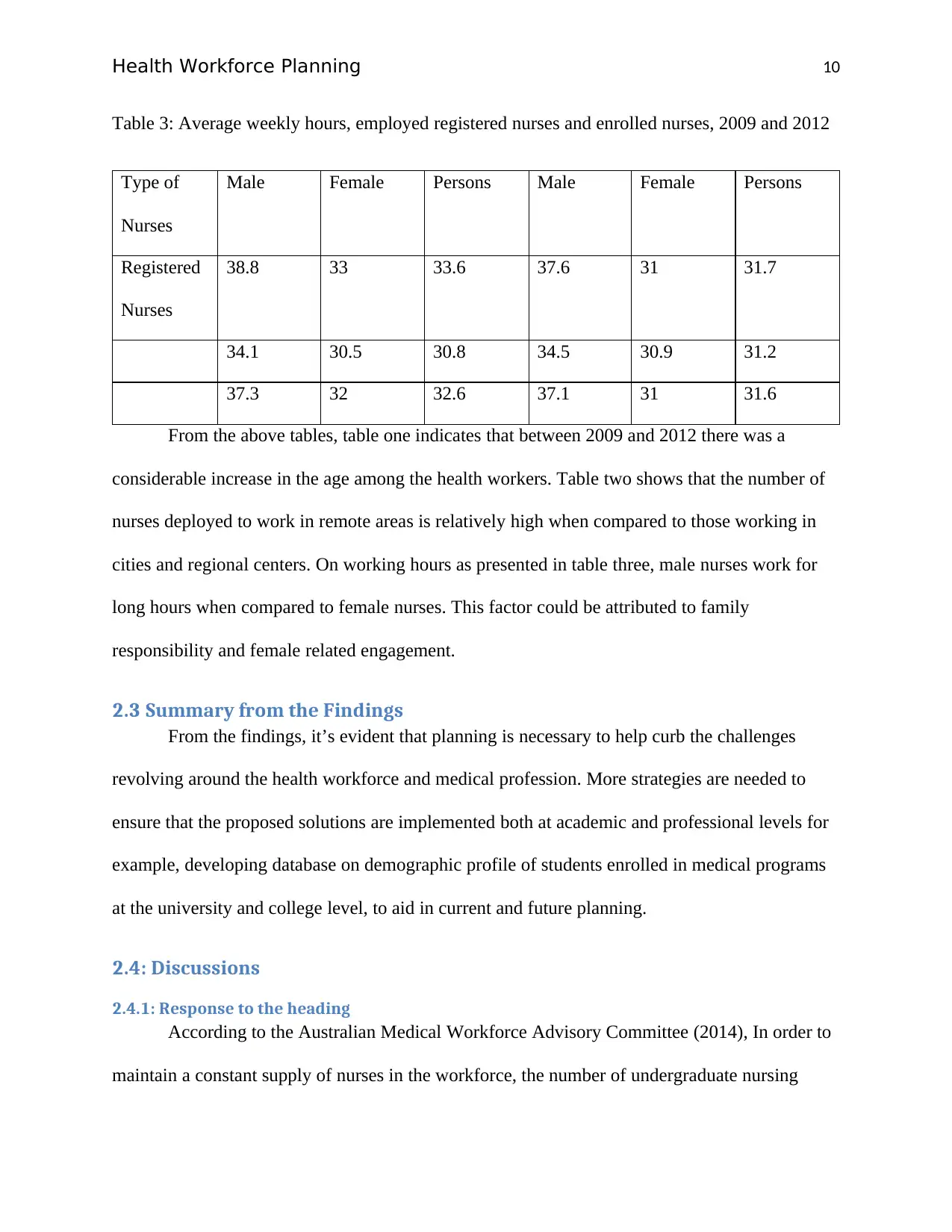
Health Workforce Planning 10
Table 3: Average weekly hours, employed registered nurses and enrolled nurses, 2009 and 2012
Type of
Nurses
Male Female Persons Male Female Persons
Registered
Nurses
38.8 33 33.6 37.6 31 31.7
34.1 30.5 30.8 34.5 30.9 31.2
37.3 32 32.6 37.1 31 31.6
From the above tables, table one indicates that between 2009 and 2012 there was a
considerable increase in the age among the health workers. Table two shows that the number of
nurses deployed to work in remote areas is relatively high when compared to those working in
cities and regional centers. On working hours as presented in table three, male nurses work for
long hours when compared to female nurses. This factor could be attributed to family
responsibility and female related engagement.
2.3 Summary from the Findings
From the findings, it’s evident that planning is necessary to help curb the challenges
revolving around the health workforce and medical profession. More strategies are needed to
ensure that the proposed solutions are implemented both at academic and professional levels for
example, developing database on demographic profile of students enrolled in medical programs
at the university and college level, to aid in current and future planning.
2.4: Discussions
2.4.1: Response to the heading
According to the Australian Medical Workforce Advisory Committee (2014), In order to
maintain a constant supply of nurses in the workforce, the number of undergraduate nursing
Table 3: Average weekly hours, employed registered nurses and enrolled nurses, 2009 and 2012
Type of
Nurses
Male Female Persons Male Female Persons
Registered
Nurses
38.8 33 33.6 37.6 31 31.7
34.1 30.5 30.8 34.5 30.9 31.2
37.3 32 32.6 37.1 31 31.6
From the above tables, table one indicates that between 2009 and 2012 there was a
considerable increase in the age among the health workers. Table two shows that the number of
nurses deployed to work in remote areas is relatively high when compared to those working in
cities and regional centers. On working hours as presented in table three, male nurses work for
long hours when compared to female nurses. This factor could be attributed to family
responsibility and female related engagement.
2.3 Summary from the Findings
From the findings, it’s evident that planning is necessary to help curb the challenges
revolving around the health workforce and medical profession. More strategies are needed to
ensure that the proposed solutions are implemented both at academic and professional levels for
example, developing database on demographic profile of students enrolled in medical programs
at the university and college level, to aid in current and future planning.
2.4: Discussions
2.4.1: Response to the heading
According to the Australian Medical Workforce Advisory Committee (2014), In order to
maintain a constant supply of nurses in the workforce, the number of undergraduate nursing
Secure Best Marks with AI Grader
Need help grading? Try our AI Grader for instant feedback on your assignments.
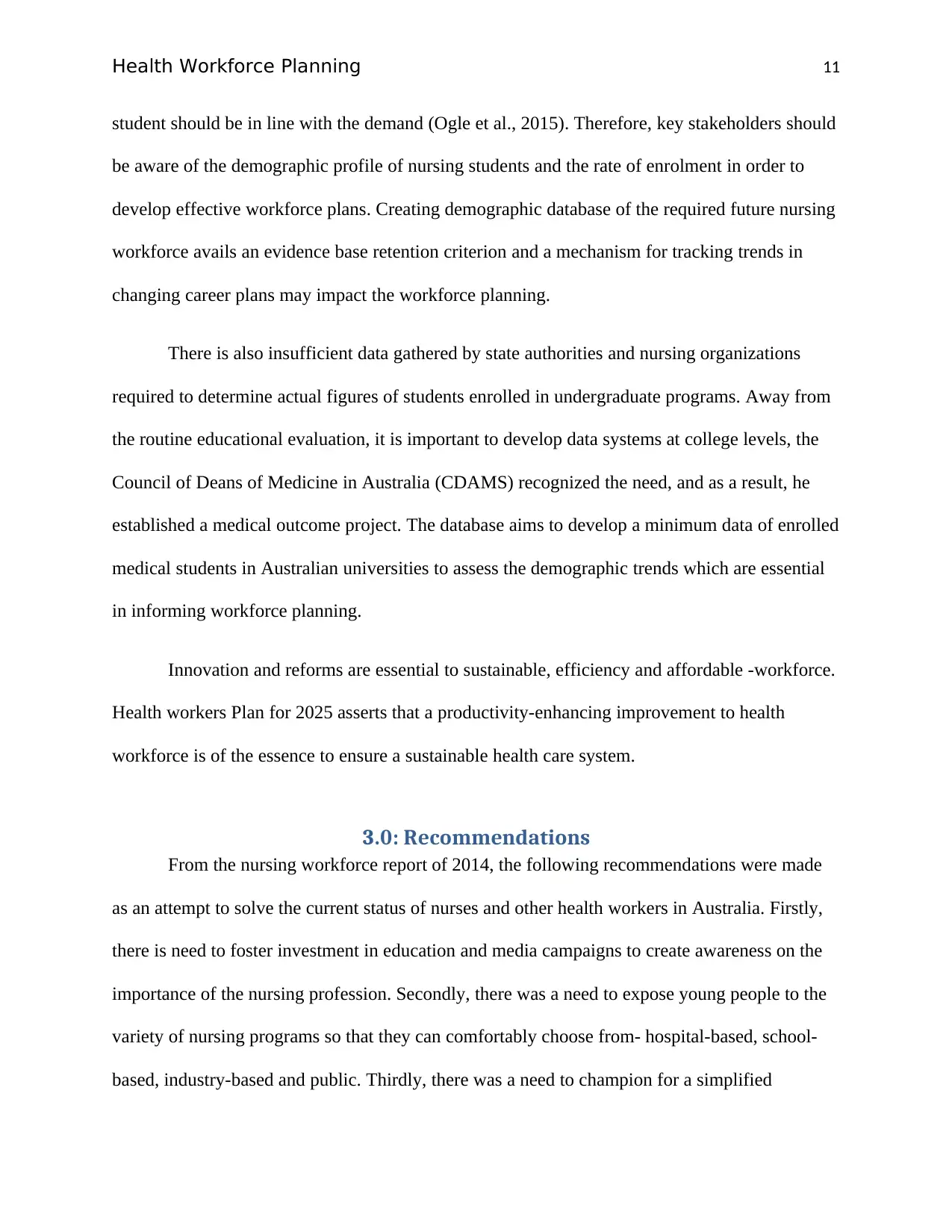
Health Workforce Planning 11
student should be in line with the demand (Ogle et al., 2015). Therefore, key stakeholders should
be aware of the demographic profile of nursing students and the rate of enrolment in order to
develop effective workforce plans. Creating demographic database of the required future nursing
workforce avails an evidence base retention criterion and a mechanism for tracking trends in
changing career plans may impact the workforce planning.
There is also insufficient data gathered by state authorities and nursing organizations
required to determine actual figures of students enrolled in undergraduate programs. Away from
the routine educational evaluation, it is important to develop data systems at college levels, the
Council of Deans of Medicine in Australia (CDAMS) recognized the need, and as a result, he
established a medical outcome project. The database aims to develop a minimum data of enrolled
medical students in Australian universities to assess the demographic trends which are essential
in informing workforce planning.
Innovation and reforms are essential to sustainable, efficiency and affordable -workforce.
Health workers Plan for 2025 asserts that a productivity-enhancing improvement to health
workforce is of the essence to ensure a sustainable health care system.
3.0: Recommendations
From the nursing workforce report of 2014, the following recommendations were made
as an attempt to solve the current status of nurses and other health workers in Australia. Firstly,
there is need to foster investment in education and media campaigns to create awareness on the
importance of the nursing profession. Secondly, there was a need to expose young people to the
variety of nursing programs so that they can comfortably choose from- hospital-based, school-
based, industry-based and public. Thirdly, there was a need to champion for a simplified
student should be in line with the demand (Ogle et al., 2015). Therefore, key stakeholders should
be aware of the demographic profile of nursing students and the rate of enrolment in order to
develop effective workforce plans. Creating demographic database of the required future nursing
workforce avails an evidence base retention criterion and a mechanism for tracking trends in
changing career plans may impact the workforce planning.
There is also insufficient data gathered by state authorities and nursing organizations
required to determine actual figures of students enrolled in undergraduate programs. Away from
the routine educational evaluation, it is important to develop data systems at college levels, the
Council of Deans of Medicine in Australia (CDAMS) recognized the need, and as a result, he
established a medical outcome project. The database aims to develop a minimum data of enrolled
medical students in Australian universities to assess the demographic trends which are essential
in informing workforce planning.
Innovation and reforms are essential to sustainable, efficiency and affordable -workforce.
Health workers Plan for 2025 asserts that a productivity-enhancing improvement to health
workforce is of the essence to ensure a sustainable health care system.
3.0: Recommendations
From the nursing workforce report of 2014, the following recommendations were made
as an attempt to solve the current status of nurses and other health workers in Australia. Firstly,
there is need to foster investment in education and media campaigns to create awareness on the
importance of the nursing profession. Secondly, there was a need to expose young people to the
variety of nursing programs so that they can comfortably choose from- hospital-based, school-
based, industry-based and public. Thirdly, there was a need to champion for a simplified
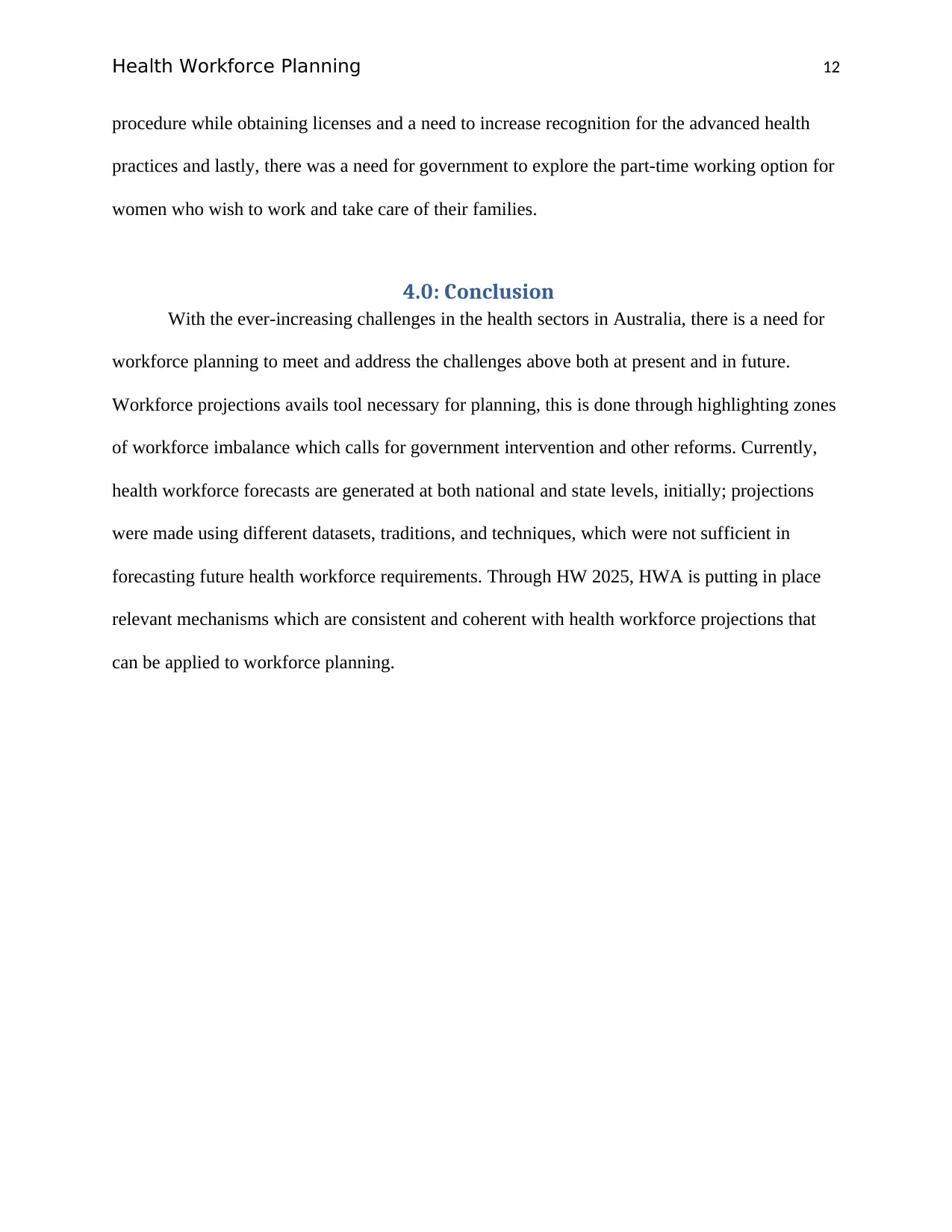
Health Workforce Planning 12
procedure while obtaining licenses and a need to increase recognition for the advanced health
practices and lastly, there was a need for government to explore the part-time working option for
women who wish to work and take care of their families.
4.0: Conclusion
With the ever-increasing challenges in the health sectors in Australia, there is a need for
workforce planning to meet and address the challenges above both at present and in future.
Workforce projections avails tool necessary for planning, this is done through highlighting zones
of workforce imbalance which calls for government intervention and other reforms. Currently,
health workforce forecasts are generated at both national and state levels, initially; projections
were made using different datasets, traditions, and techniques, which were not sufficient in
forecasting future health workforce requirements. Through HW 2025, HWA is putting in place
relevant mechanisms which are consistent and coherent with health workforce projections that
can be applied to workforce planning.
procedure while obtaining licenses and a need to increase recognition for the advanced health
practices and lastly, there was a need for government to explore the part-time working option for
women who wish to work and take care of their families.
4.0: Conclusion
With the ever-increasing challenges in the health sectors in Australia, there is a need for
workforce planning to meet and address the challenges above both at present and in future.
Workforce projections avails tool necessary for planning, this is done through highlighting zones
of workforce imbalance which calls for government intervention and other reforms. Currently,
health workforce forecasts are generated at both national and state levels, initially; projections
were made using different datasets, traditions, and techniques, which were not sufficient in
forecasting future health workforce requirements. Through HW 2025, HWA is putting in place
relevant mechanisms which are consistent and coherent with health workforce projections that
can be applied to workforce planning.
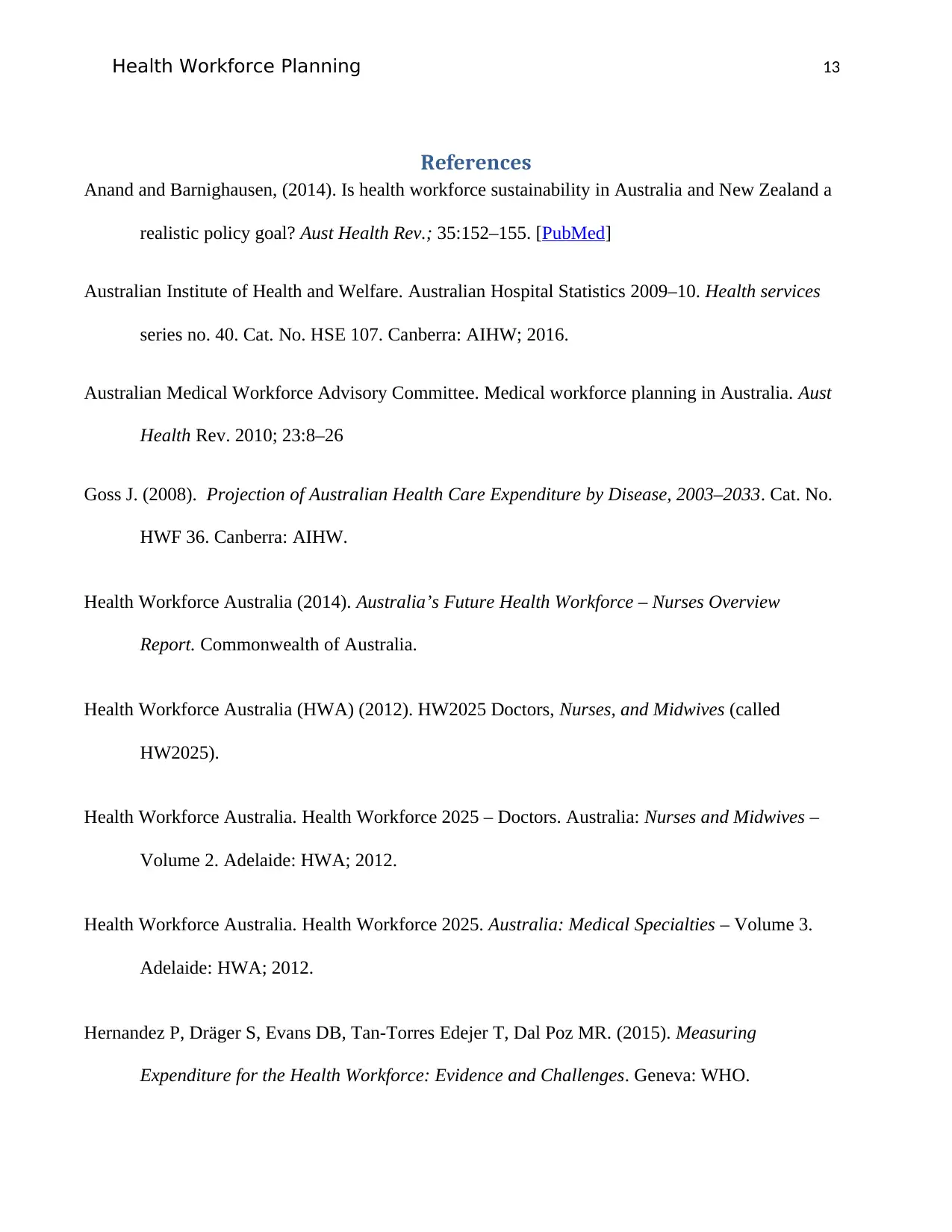
Health Workforce Planning 13
References
Anand and Barnighausen, (2014). Is health workforce sustainability in Australia and New Zealand a
realistic policy goal? Aust Health Rev.; 35:152–155. [PubMed]
Australian Institute of Health and Welfare. Australian Hospital Statistics 2009–10. Health services
series no. 40. Cat. No. HSE 107. Canberra: AIHW; 2016.
Australian Medical Workforce Advisory Committee. Medical workforce planning in Australia. Aust
Health Rev. 2010; 23:8–26
Goss J. (2008). Projection of Australian Health Care Expenditure by Disease, 2003–2033. Cat. No.
HWF 36. Canberra: AIHW.
Health Workforce Australia (2014). Australia’s Future Health Workforce – Nurses Overview
Report. Commonwealth of Australia.
Health Workforce Australia (HWA) (2012). HW2025 Doctors, Nurses, and Midwives (called
HW2025).
Health Workforce Australia. Health Workforce 2025 – Doctors. Australia: Nurses and Midwives –
Volume 2. Adelaide: HWA; 2012.
Health Workforce Australia. Health Workforce 2025. Australia: Medical Specialties – Volume 3.
Adelaide: HWA; 2012.
Hernandez P, Dräger S, Evans DB, Tan-Torres Edejer T, Dal Poz MR. (2015). Measuring
Expenditure for the Health Workforce: Evidence and Challenges. Geneva: WHO.
References
Anand and Barnighausen, (2014). Is health workforce sustainability in Australia and New Zealand a
realistic policy goal? Aust Health Rev.; 35:152–155. [PubMed]
Australian Institute of Health and Welfare. Australian Hospital Statistics 2009–10. Health services
series no. 40. Cat. No. HSE 107. Canberra: AIHW; 2016.
Australian Medical Workforce Advisory Committee. Medical workforce planning in Australia. Aust
Health Rev. 2010; 23:8–26
Goss J. (2008). Projection of Australian Health Care Expenditure by Disease, 2003–2033. Cat. No.
HWF 36. Canberra: AIHW.
Health Workforce Australia (2014). Australia’s Future Health Workforce – Nurses Overview
Report. Commonwealth of Australia.
Health Workforce Australia (HWA) (2012). HW2025 Doctors, Nurses, and Midwives (called
HW2025).
Health Workforce Australia. Health Workforce 2025 – Doctors. Australia: Nurses and Midwives –
Volume 2. Adelaide: HWA; 2012.
Health Workforce Australia. Health Workforce 2025. Australia: Medical Specialties – Volume 3.
Adelaide: HWA; 2012.
Hernandez P, Dräger S, Evans DB, Tan-Torres Edejer T, Dal Poz MR. (2015). Measuring
Expenditure for the Health Workforce: Evidence and Challenges. Geneva: WHO.
Paraphrase This Document
Need a fresh take? Get an instant paraphrase of this document with our AI Paraphraser
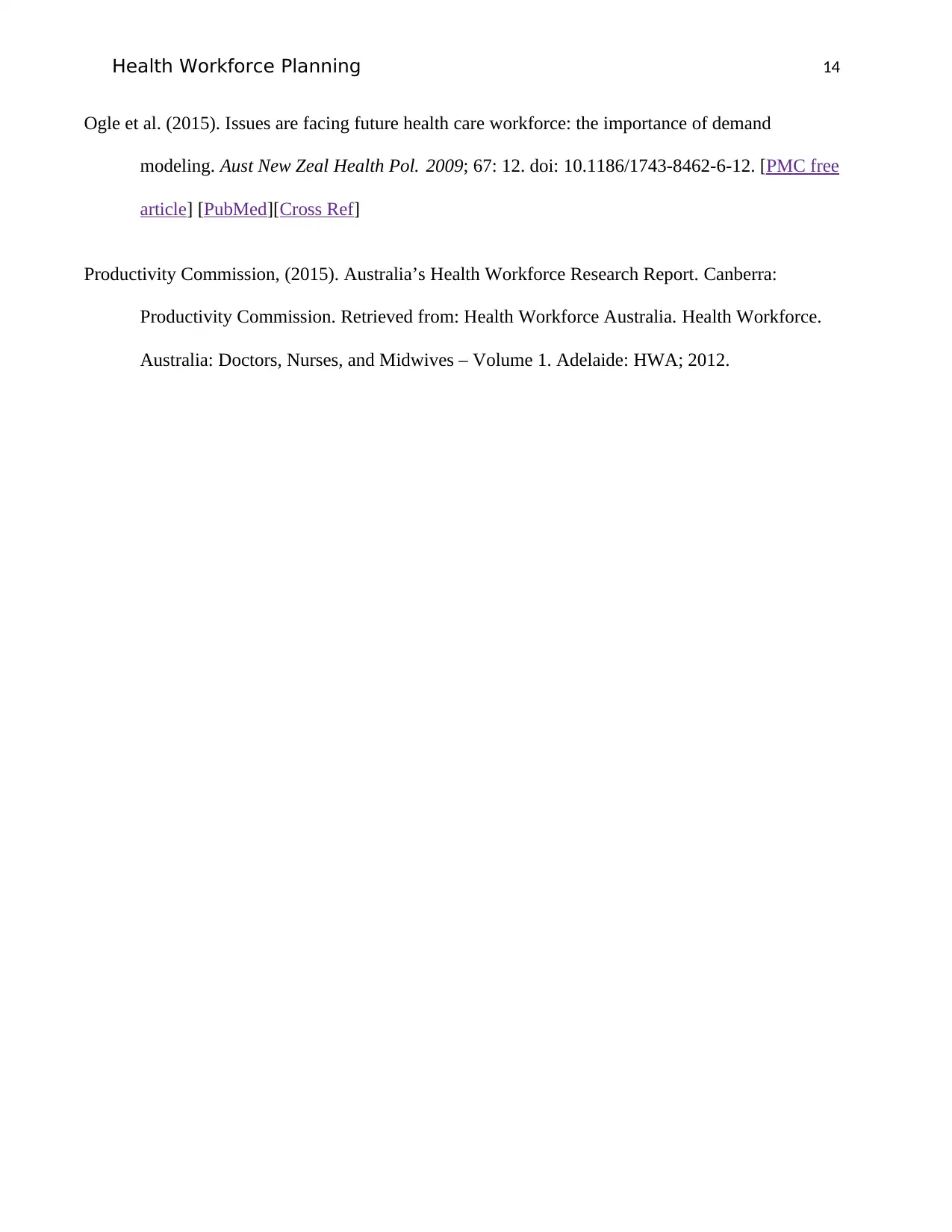
Health Workforce Planning 14
Ogle et al. (2015). Issues are facing future health care workforce: the importance of demand
modeling. Aust New Zeal Health Pol. 2009; 67: 12. doi: 10.1186/1743-8462-6-12. [PMC free
article] [PubMed][Cross Ref]
Productivity Commission, (2015). Australia’s Health Workforce Research Report. Canberra:
Productivity Commission. Retrieved from: Health Workforce Australia. Health Workforce.
Australia: Doctors, Nurses, and Midwives – Volume 1. Adelaide: HWA; 2012.
Ogle et al. (2015). Issues are facing future health care workforce: the importance of demand
modeling. Aust New Zeal Health Pol. 2009; 67: 12. doi: 10.1186/1743-8462-6-12. [PMC free
article] [PubMed][Cross Ref]
Productivity Commission, (2015). Australia’s Health Workforce Research Report. Canberra:
Productivity Commission. Retrieved from: Health Workforce Australia. Health Workforce.
Australia: Doctors, Nurses, and Midwives – Volume 1. Adelaide: HWA; 2012.
1 out of 14
Related Documents
Your All-in-One AI-Powered Toolkit for Academic Success.
+13062052269
info@desklib.com
Available 24*7 on WhatsApp / Email
![[object Object]](/_next/static/media/star-bottom.7253800d.svg)
Unlock your academic potential
© 2024 | Zucol Services PVT LTD | All rights reserved.




